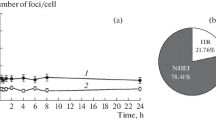Abstract
LABELLING of chromosomal deoxyribonucleic acid (DNA) with tritium-labelled thymidine (H3TDR) demands consideration of the probabilities of long-term retention of the label and damage to somatic and genetic cells. These are important for the interpretation of results and for consideration of hazards associated with the use of tritiated thymidine in human beings. The model proposed by Taylor, Woods and Hughes1 permits prediction of the persistence of the label, an implication which has not been adequately explored in previous publications by ourselves and others2–4. The model is based on autoradiographic observations on plant chromosomes labelled with H3TDR during replication. In this model each chromosome is considered to consist of two halves (chromatids), both of which replicate. If H3TDR is available during DNA synthesis for a finite period, both half-chromosomes will be labelled in their newly formed replicas. On division, all chromosomes of the daughter cells will contain the label in the newly replicated chromatid. Subsequent DNA synthesis proceeds without further availability of H3TDR, and newly formed replicas of both labelled and unlabelled chromatids will be unlabelled.
Similar content being viewed by others
References
Taylor, J. H., Woods, P. S., and Hughes, W. L., Proc. U.S. Nat. Acad. Sci., 43, 122 (1957).
Hughes, W. L., Bond, V. P., Brecher, G., Cronkite, E. P., Painter, R. B., Quastler, H., and Sherman, F. G., Proc. U.S. Nat. Acad. Sci., 44, 476 (1958).
Cronkite, E. P., Bond, V. P., Fliedner, T. M., and Rubini, J. R., Lab. Invest., 8, 263 (1959).
Stohlman, jun., F., edit., “Kinetics of Cellular Proliferation” (Grune and Stratton, New York, 1959).
Mendelsohn, M. L., J. Nat. Cancer Inst., 25, 485 (1960).
Author information
Authors and Affiliations
Rights and permissions
About this article
Cite this article
CRONKITE, E., GREENHOUSE, S., BRECHER, G. et al. Implication of Chromosome Structure and Replication on Hazard of Tritiated Thymidine and the Interpretation of Data on Cell Proliferation. Nature 189, 153–154 (1961). https://doi.org/10.1038/189153a0
Issue Date:
DOI: https://doi.org/10.1038/189153a0
- Springer Nature Limited
This article is cited by
-
Zellteilungen und Zellwanderungen im Thymus der erwachsenen Maus
Zeitschrift f�r Zellforschung und Mikroskopische Anatomie (1965)





